Your website has a chatbot to assist customers.
You need to detect when a customer is upset based on what the customer types in the chatbot.
Which type of AI workload should you use?
Answer:
D
Natural language processing (NLP) is used for tasks such as sentiment analysis, topic detection, language detection, key phrase extraction, and document categorization.
Sentiment Analysis is the process of determining whether a piece of writing is positive, negative or neutral.
Reference:
https://docs.microsoft.com/en-us/azure/architecture/data-guide/technology-choices/natural-language-processing
You plan to develop a bot that will enable users to query a knowledge base by using natural language processing.
Which two services should you include in the solution? Each correct answer presents part of the solution.
NOTE: Each correct selection is worth one point.
Answer:
AB
Reference:
https://docs.microsoft.com/en-us/azure/bot-service/bot-service-overview-introduction?view=azure-bot-service-4.0 https://docs.microsoft.com/en-us/azure/cognitive-services/luis/choose-natural-language-processing-service
In which two scenarios can you use a speech synthesis solution? Each correct answer presents a complete solution.
NOTE: Each correct selection is worth one point.
Answer:
AD
Azure Text to Speech is a Speech service feature that converts text to lifelike speech.
Incorrect Answers:
C: Extracting key phrases is not speech synthesis.
Reference:
https://azure.microsoft.com/en-in/services/cognitive-services/text-to-speech/
HOTSPOT -
For each of the following statements, select Yes if the statement is true. Otherwise, select No.
NOTE: Each correct selection is worth one point.
Hot Area: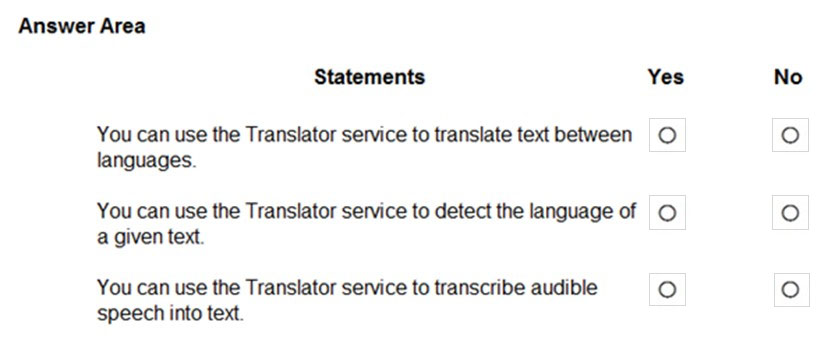
Answer:
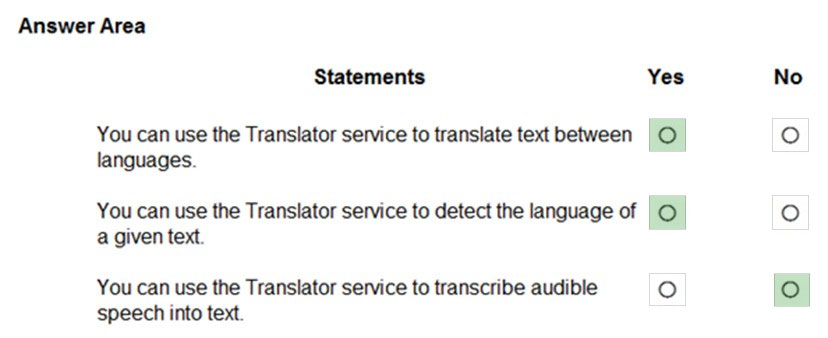
The translator service provides multi-language support for text translation, transliteration, language detection, and dictionaries.
Speech-to-Text, also known as automatic speech recognition (ASR), is a feature of Speech Services that provides transcription.
Reference:
https://docs.microsoft.com/en-us/azure/cognitive-services/Translator/translator-info-overview https://docs.microsoft.com/en-us/legal/cognitive-services/speech-service/speech-to-text/transparency-note
DRAG DROP -
You need to scan the news for articles about your customers and alert employees when there is a negative article. Positive articles must be added to a press book.
Which natural language processing tasks should you use to complete the process? To answer, drag the appropriate tasks to the correct locations. Each task may be used once, more than once, or not at all. You may need to drag the split bar between panes or scroll to view content.
NOTE: Each correct selection is worth one point.
Select and Place: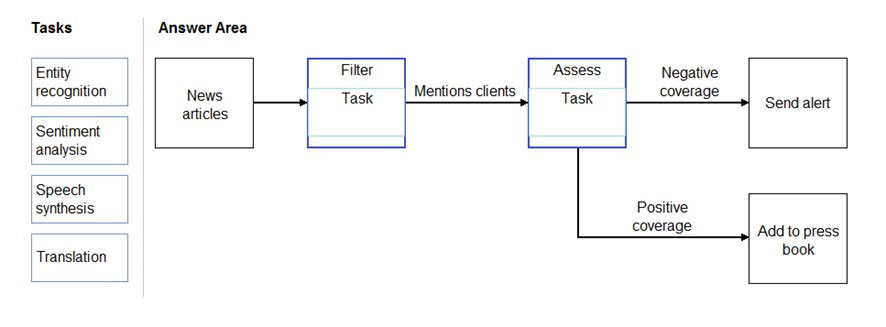
Answer:
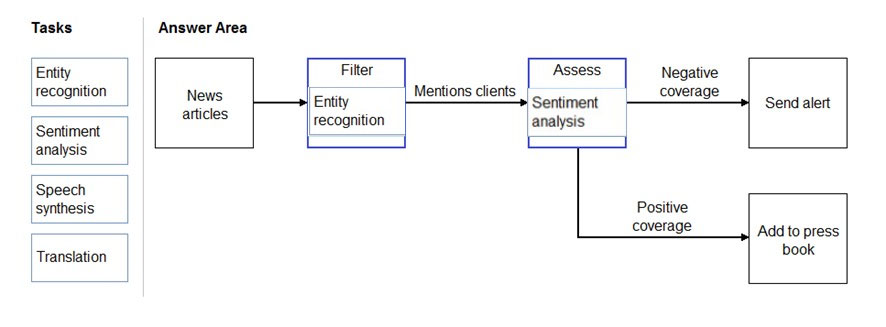
Box 1: Entity recognition -
the Named Entity Recognition module in Machine Learning Studio (classic), to identify the names of things, such as people, companies, or locations in a column of text.
Named entity recognition is an important area of research in machine learning and natural language processing (NLP), because it can be used to answer many real-world questions, such as:
✑ Which companies were mentioned in a news article?
✑ Does a tweet contain the name of a person? Does the tweet also provide his current location?
✑ Were specified products mentioned in complaints or reviews?
Box 2: Sentiment Analysis -
The Text Analytics API's Sentiment Analysis feature provides two ways for detecting positive and negative sentiment. If you send a Sentiment Analysis request, the API will return sentiment labels (such as "negative", "neutral" and "positive") and confidence scores at the sentence and document-level.
Reference:
https://docs.microsoft.com/en-us/azure/machine-learning/studio-module-reference/named-entity-recognition https://docs.microsoft.com/en-us/azure/cognitive-services/text-analytics/how-tos/text-analytics-how-to-sentiment-analysis
You are building a knowledge base by using QnA Maker.
Which file format can you use to populate the knowledge base?
Answer:
D
D: Content types of documents you can add to a knowledge base:
Content types include many standard structured documents such as PDF, DOC, and TXT.
Note: The tool supports the following file formats for ingestion:
✑ .tsv: QnA contained in the format Question(tab)Answer.
✑ .txt, .docx, .pdf: QnA contained as regular FAQ content--that is, a sequence of questions and answers.
Incorrect Answers:
A: PPTX is the default presentation file format for new PowerPoint presentations.
B: It is not possible to ingest xml file directly.
Reference:
https://docs.microsoft.com/en-us/azure/cognitive-services/qnamaker/concepts/data-sources-and-content
In which scenario should you use key phrase extraction?
Answer:
C
You have insurance claim reports that are stored as text.
You need to extract key terms from the reports to generate summaries.
Which type of AI workload should you use?
Answer:
A
Reference:
https://docs.microsoft.com/en-us/azure/architecture/data-guide/technology-choices/natural-language-processing
HOTSPOT -
To complete the sentence, select the appropriate option in the answer area.
Hot Area: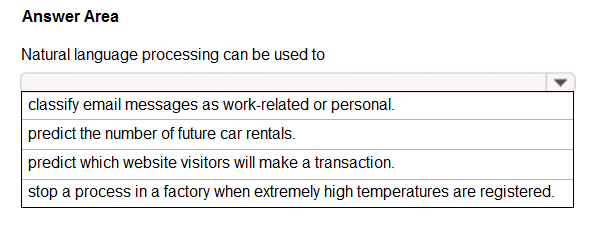
Answer:
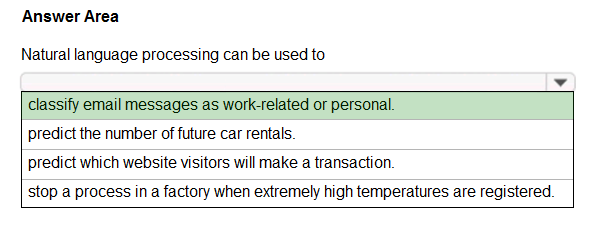
Natural language processing (NLP) is used for tasks such as sentiment analysis, topic detection, language detection, key phrase extraction, and document categorization.
Reference:
https://docs.microsoft.com/en-us/azure/architecture/data-guide/technology-choices/natural-language-processing
Which AI service can you use to interpret the meaning of a user input such as `Call me back later?`
Answer:
D
Language Understanding (LUIS) is a cloud-based AI service, that applies custom machine-learning intelligence to a user's conversational, natural language text to predict overall meaning, and pull out relevant, detailed information.
Reference:
https://docs.microsoft.com/en-us/azure/cognitive-services/luis/what-is-luis